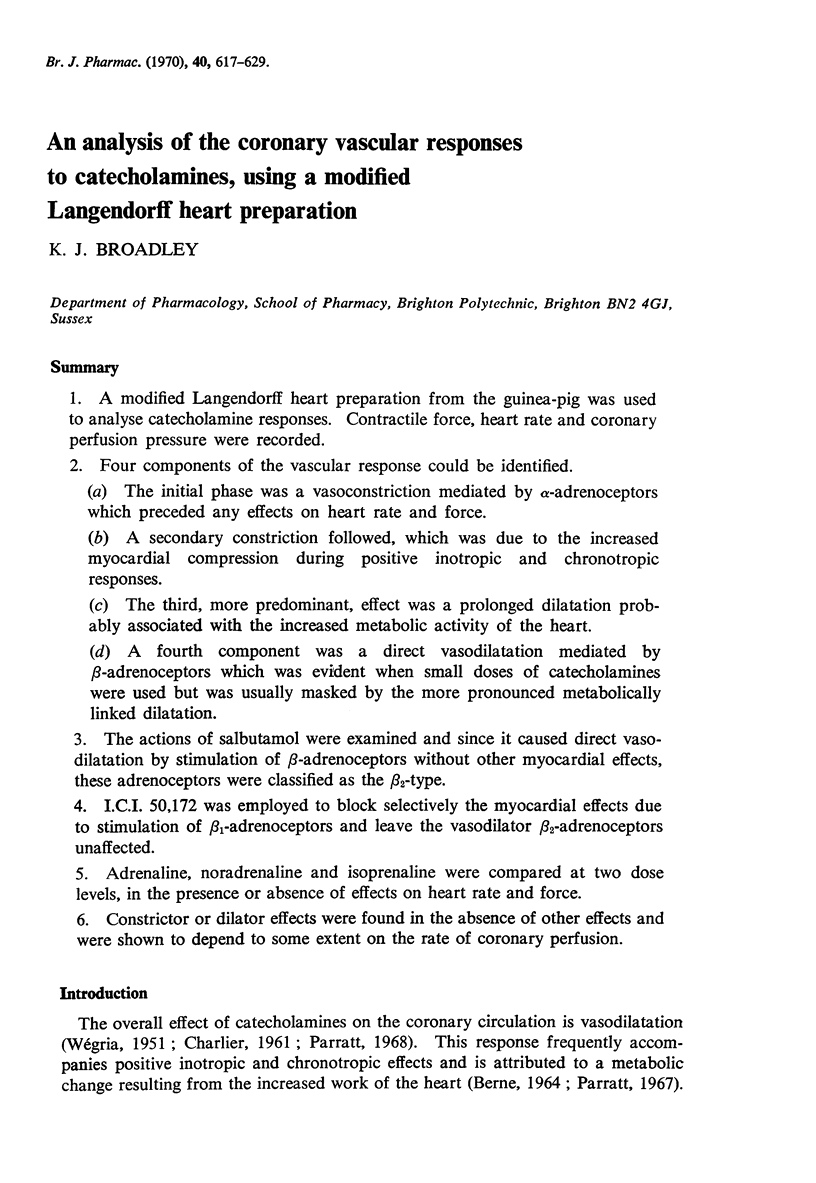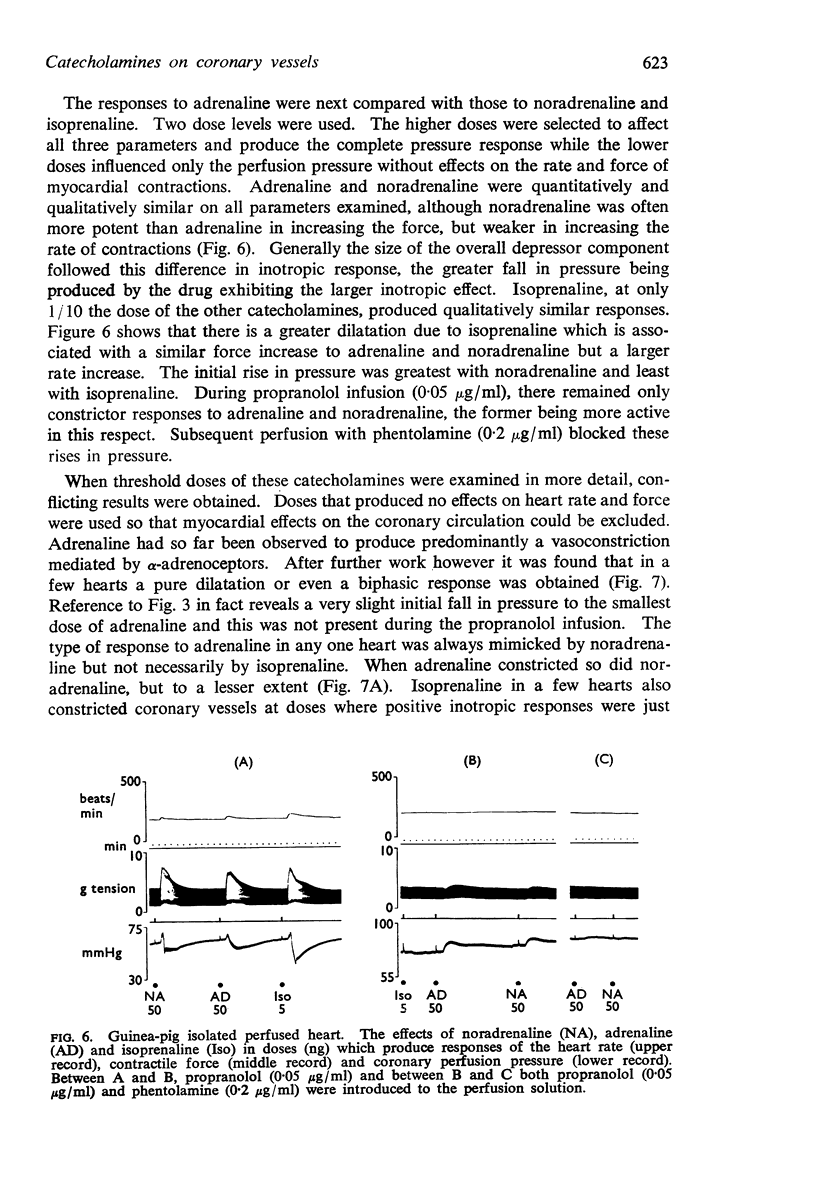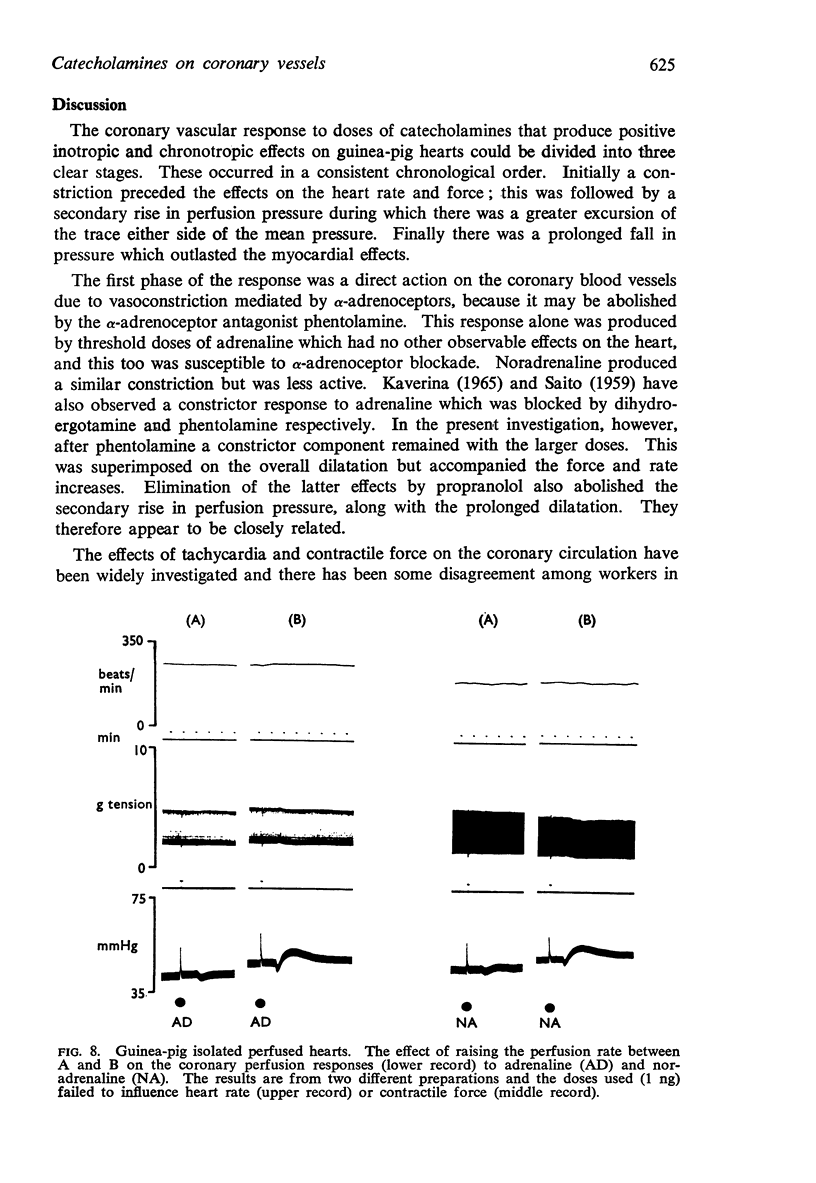Abstract
1. A modified Langendorff heart preparation from the guinea-pig was used to analyse catecholamine responses. Contractile force, heart rate and coronary perfusion pressure were recorded.
2. Four components of the vascular response could be identified.
(a) The initial phase was a vasoconstriction mediated by α-adrenoceptors which preceded any effects on heart rate and force.
(b) A secondary constriction followed, which was due to the increased myocardial compression during positive inotropic and chronotropic responses.
(c) The third, more predominant, effect was a prolonged dilatation probably associated with the increased metabolic activity of the heart.
(d) A fourth component was a direct vasodilatation mediated by β-adrenoceptors which was evident when small doses of catecholamines were used but was usually masked by the more pronounced metabolically linked dilatation.
3. The actions of salbutamol were examined and since it caused direct vasodilatation by stimulation of β-adrenoceptors without other myocardial effects, these adrenoceptors were classified as the β2-type.
4. I.C.I. 50,172 was employed to block selectively the myocardial effects due to stimulation of β1-adrenoceptors and leave the vasodilator β2-adrenoceptors unaffected.
5. Adrenaline, noradrenaline and isoprenaline were compared at two dose levels, in the presence or absence of effects on heart rate and force.
6. Constrictor or dilator effects were found in the absence of other effects and were shown to depend to some extent on the rate of coronary perfusion.
Full text
PDF












Selected References
These references are in PubMed. This may not be the complete list of references from this article.
- Anrep G. V., Häusler H. The coronary circulation: II. The effect of changes of temperature and of heart rate. J Physiol. 1929 Jun 7;67(3):299–314. doi: 10.1113/jphysiol.1929.sp002571. [DOI] [PMC free article] [PubMed] [Google Scholar]
- BARDHANABAEDYA S., DENISON A. B., Jr, GREEN H. D. Adrenergic drugs and blockade on coronary arterioles and myocardial contraction. Circ Res. 1956 Nov;4(6):653–658. doi: 10.1161/01.res.4.6.653. [DOI] [PubMed] [Google Scholar]
- BERNE R. M., BLACKMON J. R., GARDNER T. H. Hypoxemia and coronary blood flow. J Clin Invest. 1957 Jul;36(7):1101–1106. doi: 10.1172/JCI103505. [DOI] [PMC free article] [PubMed] [Google Scholar]
- BERNE R. M. Effect of epinephrine and norepinephrine on coronary circulation. Circ Res. 1958 Sep;6(5):644–655. doi: 10.1161/01.res.6.5.644. [DOI] [PubMed] [Google Scholar]
- BERNE R. M. REGULATION OF CORONARY BLOOD FLOW. Physiol Rev. 1964 Jan;44:1–29. doi: 10.1152/physrev.1964.44.1.1. [DOI] [PubMed] [Google Scholar]
- Cullum V. A., Farmer J. B., Jack D., Levy G. P. Salbutamol: a new, selective beta-adrenoceptive receptor stimulant. Br J Pharmacol. 1969 Jan;35(1):141–151. doi: 10.1111/j.1476-5381.1969.tb07975.x. [DOI] [PMC free article] [PubMed] [Google Scholar]
- DOUGLAS R. C., ARMENGOL V., TALESNIK J. Influence of cardiac activity on coronary flow control. Acta Physiol Lat Am. 1960;10:205–216. [PubMed] [Google Scholar]
- DOUTHEIL U., BRUGGENCATE H. G., KRAMER K. CORONARVASOMOTORIK UNTER L-NORADRENALIN UND ISOPROPYLNORADRENALIN NACH BLOCKIERUNG DER ADRENERGISCHEN BETA-RECEPTOREN DURCH NETHALIDE. Pflugers Arch Gesamte Physiol Menschen Tiere. 1964 Oct 5;281:181–190. doi: 10.1007/BF00363626. [DOI] [PubMed] [Google Scholar]
- DRISCOL T. E., BERNE R. M. Role of potassium in regulation of coronary blood flow. Proc Soc Exp Biol Med. 1957 Nov;96(2):505–508. doi: 10.3181/00379727-96-23521. [DOI] [PubMed] [Google Scholar]
- Dawes G. S. The vaso-dilator action of potassium. J Physiol. 1941 Jan 14;99(2):224–238. doi: 10.1113/jphysiol.1941.sp003895. [DOI] [PMC free article] [PubMed] [Google Scholar]
- Dunlop D., Shanks R. G. Selective blockade of adrenoceptive beta receptors in the heart. Br J Pharmacol Chemother. 1968 Jan;32(1):201–218. doi: 10.1111/j.1476-5381.1968.tb00444.x. [DOI] [PMC free article] [PubMed] [Google Scholar]
- FEINBERG H., KATZ L. N., BOYD E. Determinants of coronary flow and myocardial oxygen consumption. Am J Physiol. 1962 Jan;202:45–52. doi: 10.1152/ajplegacy.1962.202.1.45. [DOI] [PubMed] [Google Scholar]
- GARCIA RAMOS J., ALANIS J., LUCO J. Estudios sobre la circulación coronaria. II. Las acciones del vago y del simpático. Arch Inst Cardiol Mex. 1950 Aug 31;20(4):534–550. [PubMed] [Google Scholar]
- GREGG D. E., SABISTON D. C., Jr Effect of cardiac contraction on coronary blood flow. Circulation. 1957 Jan;15(1):14–20. doi: 10.1161/01.cir.15.1.14. [DOI] [PubMed] [Google Scholar]
- GUZ A., KURLAND G. S., FREEDBERG A. S. Relation of coronary flow to oxygen supply. Am J Physiol. 1960 Jul;199:179–182. doi: 10.1152/ajplegacy.1960.199.1.179. [DOI] [PubMed] [Google Scholar]
- Gaal P. G., Kattus A. A., Kolin A., Ross G. Effects of adrenaline and noradrenaline on coronary blood flow before and after beta-adrenergic blockade. Br J Pharmacol Chemother. 1966 Mar;26(3):713–722. doi: 10.1111/j.1476-5381.1966.tb01851.x. [DOI] [PMC free article] [PubMed] [Google Scholar]
- HARDIN R. A., SCOTT J. B., HADDY F. J. Effect of epinephrine and norepinephrine on coronary vascular resistance in dogs. Am J Physiol. 1961 Aug;201:276–280. doi: 10.1152/ajplegacy.1961.201.2.276. [DOI] [PubMed] [Google Scholar]
- HASHIMOTO K., SHIGEI T., IMAI S., SAITO Y., YAGO N., UEI I., CLARK R. E. Oxygen consumption and coronary vascular tone in the isolated fibrillating dog heart. Am J Physiol. 1960 May;198:965–970. doi: 10.1152/ajplegacy.1960.198.5.965. [DOI] [PubMed] [Google Scholar]
- KLOCKE F. J., KAISER G. A., ROSS J., Jr, BRAUNWALD E. AN INTRINSIC ADRENERGIC VASODILATOR MECHANISM IN THE CORONARY VASCULAR BED OF THE DOG. Circ Res. 1965 Apr;16:376–382. doi: 10.1161/01.res.16.4.376. [DOI] [PubMed] [Google Scholar]
- LEUSEN I. R., ESSEX H. E. Effects of epinephrine, nor-epinephrine and khellin on circulation through isolated perfused hearts. Am J Physiol. 1953 Jan;172(1):226–230. doi: 10.1152/ajplegacy.1952.172.1.226. [DOI] [PubMed] [Google Scholar]
- LEWIS F. B., COFFMAN J. D., GREGG D. E. Effect of heart rate and intracoronary isoproterenol, levarterenol, and epinephrine on coronary flow and resistance. Circ Res. 1961 Jan;9:89–95. doi: 10.1161/01.res.9.1.89. [DOI] [PubMed] [Google Scholar]
- LUDUENA F. P., MILLER E., WILT W. A. A new perfusion apparatus for the study of the effects of drugs on the coronary vessels. J Am Pharm Assoc Am Pharm Assoc. 1955 Jun;44(6):363–366. doi: 10.1002/jps.3030440617. [DOI] [PubMed] [Google Scholar]
- Lands A. M., Arnold A., McAuliff J. P., Luduena F. P., Brown T. G., Jr Differentiation of receptor systems activated by sympathomimetic amines. Nature. 1967 May 6;214(5088):597–598. doi: 10.1038/214597a0. [DOI] [PubMed] [Google Scholar]
- Lochner W., Parratt J. R. A comparison of the effects of locally and systemically administered kinins on coronary blood flow and myocardial metabolism. Br J Pharmacol Chemother. 1966 Jan;26(1):17–26. doi: 10.1111/j.1476-5381.1966.tb01806.x. [DOI] [PMC free article] [PubMed] [Google Scholar]
- MELVILLE K. I., LU F. C. Effect of epinephrine, aminophylline, nitroglycerine and papaverine on coronary inflow and on heart contraction, as recorded concurrently. J Pharmacol Exp Ther. 1950 Jul;99(3):286–303. [PubMed] [Google Scholar]
- MOHME-LUNDHOLM E. Mechanism of the relaxing effect of adrenaline on bovine coronary vessels. Acta Physiol Scand. 1957 Mar 7;38(3-4):255–264. doi: 10.1111/j.1748-1716.1957.tb01388.x. [DOI] [PubMed] [Google Scholar]
- PARRATT J. R. A COMPARISON OF THE EFFECTS OF THE PLASMA KININS, BRADYKININ AND KALLIDIN, ON MYOCARDIAL BLOOD FLOW AND METABOLISM. Br J Pharmacol Chemother. 1964 Feb;22:34–46. doi: 10.1111/j.1476-5381.1964.tb01541.x. [DOI] [PMC free article] [PubMed] [Google Scholar]
- PARRATT J. R. BLOCKAGE OF SYMPATHETIC BETA-RECEPTORS IN THE MYOCARDIAL CIRCULATION. Br J Pharmacol Chemother. 1965 Jun;24:601–611. doi: 10.1111/j.1476-5381.1965.tb01616.x. [DOI] [PMC free article] [PubMed] [Google Scholar]
- Parratt J. R., Wadsworth R. M. The effect of "selective" beta-receptor blocking drugs on the myocardial circulation. Br J Pharmacol. 1969 Oct;37(2):524P–526P. [PMC free article] [PubMed] [Google Scholar]
- Rubio R., Berne R. M. Release of adenosine by the normal myocardium in dogs and its relationship to the regulation of coronary resistance. Circ Res. 1969 Oct;25(4):407–415. doi: 10.1161/01.res.25.4.407. [DOI] [PubMed] [Google Scholar]
- SIEGEL J. H., GILMORE J. P., SARNOFF S. J. Myocardial extraction and production of catechol amines. Circ Res. 1961 Nov;9:1336–1350. doi: 10.1161/01.res.9.6.1336. [DOI] [PubMed] [Google Scholar]
- WEGRIA R., FRANK C. W., WANG H. H., LAMMERANT J. The effect of atrial and ventricular tachycardia on cardiac output, coronary blood flow and mean arterial blood pressure. Circ Res. 1958 Sep;6(5):624–632. doi: 10.1161/01.res.6.5.624. [DOI] [PubMed] [Google Scholar]
- WEGRIA R. Pharmacology of the coronary circulation. Pharmacol Rev. 1951 Jun;3(2):197–246. [PubMed] [Google Scholar]
- WIGGERS C. J. The interplay of coronary vascular resistance and myocardial compression in regulating coronary flow. Circ Res. 1954 May;2(3):271–279. doi: 10.1161/01.res.2.3.271. [DOI] [PubMed] [Google Scholar]
- ZUBERBUHLER R. C., BOHR D. F. RESPONSES OF CORONARY SMOOTH MUSCLE TO CATECHOLAMINES. Circ Res. 1965 May;16:431–440. doi: 10.1161/01.res.16.5.431. [DOI] [PubMed] [Google Scholar]


